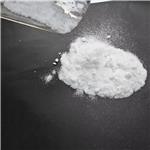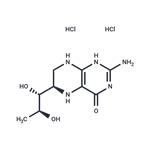
Sapropterin Hydrochloride
- Product NameSapropterin Hydrochloride
- CAS69056-38-8
- CBNumberCB9206285
- MFC9H17Cl2N5O3
- MW314.17
- EINECS663-669-3
- MDL NumberMFCD00891665
- MOL File69056-38-8.mol
Chemical Properties
| Melting point | 245-246° (dec) |
| alpha | D25 -6.81° (c = 0.665 in 0.1 M HCl) |
| storage temp. | -20°C |
| solubility | water, oxygen free: soluble19.60 - 20.40mg/mL, clear to slightly hazy, colorless to faintly yellow |
| form | White to off-white powder. |
| color | White to off-white |
| Water Solubility | water, oxygen free: soluble 19.60-20.40mg/mL, clear to slightly hazy, colorless to faintly yellow |
| Stability | Hygroscopic |
| CAS DataBase Reference | 69056-38-8(CAS DataBase Reference) |
| FDA UNII | RG277LF5B3 |
| UNSPSC Code | 12352200 |
| NACRES | NA.77 |
Safety
| Symbol(GHS) |

|
|||||||||
| Signal word | Warning | |||||||||
| Hazard statements | H302 | |||||||||
| Precautionary statements | P280-P305+P351+P338 | |||||||||
| Hazard Codes | Xn | |||||||||
| Risk Statements | 22 | |||||||||
| WGK Germany | 3 | |||||||||
| RTECS | UO3516500 | |||||||||
| Toxicity | LD50 oral in rat: 1gm/kg | |||||||||
| NFPA 704: |
|


